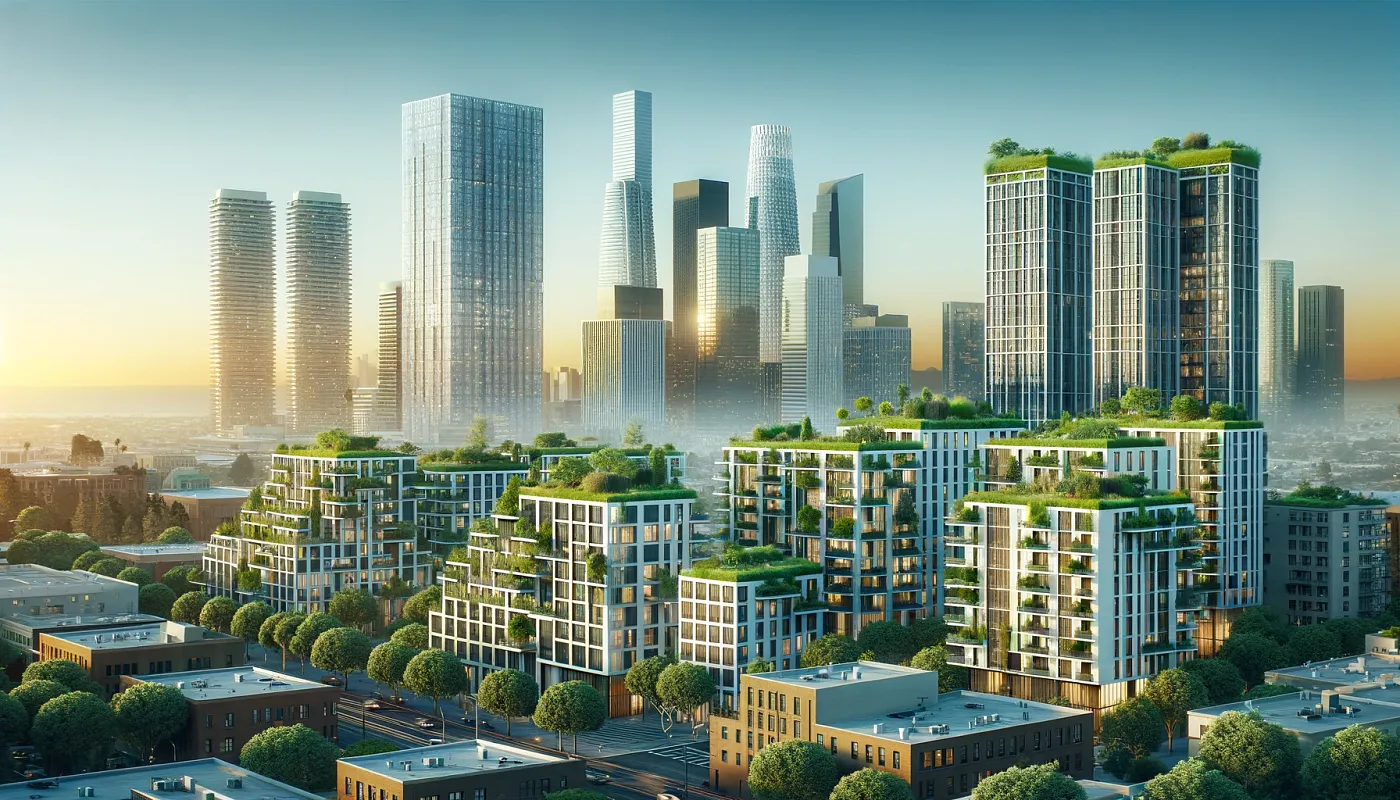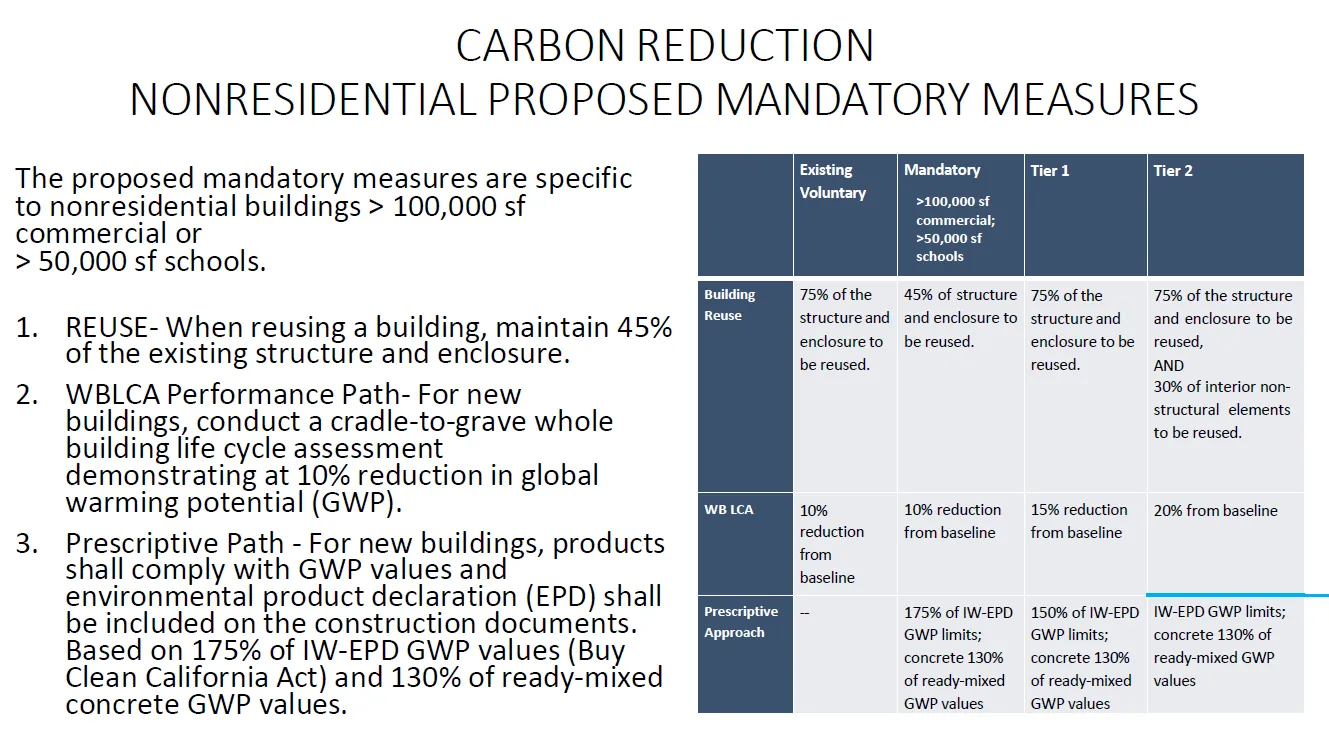Integrating CALGreen Standards with 2050 Materials’ Data, Tools, and APIs for Embodied Carbon Reduction
In an era marked by environmental consciousness and regulatory progression, the intersection of CALGreen standards with the innovative solutions provided by 2050 Materials symbolizes a transformative shift in the construction industry.
This article provides a comprehensive understanding of how CALGreen’s mandatory measures for embodied carbon reduction intertwine with the advanced data, tools, and APIs offered by 2050 Materials, setting a new benchmark for sustainable building practices.

Introduction to CALGreen
In September 2023, California etched its name in history as the first state to incorporate Embodied Carbon Emission Control as a compulsory element of the building code, marking a significant leap in the quest for sustainable construction. The CALGreen Mandatory Measures, spearheaded by the visionary insights of Michael Malinowski, FAIA, aim to radically diminish the carbon footprint of buildings, addressing the 13% global CO2 emissions attributed to embodied carbon.
The Imperative of Embodied Carbon Reduction: California’s Pioneering Legislation
The establishment of the CALGreen’s Mandatory Measures is not merely a regulatory update; it’s a response to the pressing need for environmental stewardship in the building sector. As the planet grapples with the consequences of climate change, California’s initiative stands as a testament to proactive and responsible governance, aligning with the state’s ambitious climate goals of a 40% carbon emission reduction by 2030 and achieving carbon neutrality by 2045.

Source: AIA
What is Embodied Carbon? Significance in Sustainable Building
Embodied Carbon, or Embodied Green House Gas Emissions, represents the carbon footprint associated with materials and construction activities. This metric is crucial in the context of sustainable building, as it accounts for a significant portion of the overall environmental impact of construction projects. The early stages of a building’s life are particularly critical, making the control of embodied carbon emissions a top priority for architects and builders alike.
CALGreen’s Evolution: Tracking the History and Improvements
CALGreen’s journey is one of continuous evolution and enhancement. From its inception to its current state, the code has progressively incorporated more robust measures to address the multifaceted challenges of sustainable construction. The 2023 update is a reflection of this school projects over 50,000 square feet. This broad applicability ensures that a significant segment of the construction industry is engaged in the pursuit of reducing embodied carbon emissions, setting a precedent for future standards and inspiring other states and nations to follow suit.
Material Selection and Usage: Navigating the Prescriptive Path
The Prescriptive path under CALGreen offers a straightforward approach to compliance, focusing on the selection of materials with a lower global warming potential. By setting a threshold of 175% of the industry average for specific materials like steel, glass, mineral wool, and concrete, CALGreen encourages builders to opt for more sustainable alternatives without compromising the integrity and functionality of their projects.
The Significance of Building Reuse: Emphasizing Sustainability
Building Reuse is a cornerstone of CALGreen’s approach to reducing embodied carbon emissions. By advocating for the retention and reuse of existing structures, this pathway not only minimizes the demand for new materials but also preserves the cultural and architectural heritage embedded in existing buildings. This approach aligns perfectly with the broader objectives of sustainable development, emphasizing conservation, efficiency, and respect for the past.
Lifecycle Assessments in Building Projects: The Role of 2050 Materials’ Data
Whole Building Life Cycle Assessments (WBLCA) play a pivotal role in the Performance pathway of CALGreen. 2050 Materials facilitates this process by providing comprehensive data and analytical tools that enable architects and builders to accurately assess the embodied carbon impact of their projects. This data-driven approach ensures that decisions made at the design and planning stages are informed, strategic, and aligned with sustainability goals.
Compliance without Complications: Simplifying the Process with Tools
The complexity of complying with CALGreen’s mandates is significantly reduced with the aid of tools and resources provided by 2050 Materials. From databases of EPDs to APIs that integrate with project management software, the platform ensures that adherence to the code is not only achievable but also streamlined and efficient.
The Genesis of CALGreen’s Requirements: Collaborative Inputs and Industry Involvement
The development of CALGreen’s standards is a testament to collaborative effort and industry-wide engagement. Drawing on insights from a multitude of stakeholders, including subject matter experts, industry leaders, and sustainability advocates, the code is a well-rounded, comprehensive framework that reflects the collective ambition of the construction industry to embrace a greener, more sustainable future.
Financial Implications of CALGreen Compliance: Cost Analysis and Feasibility
One of the remarkable aspects of CALGreen’s 2023 update is its consideration of the financial implications for the construction industry. The code is structured to offer multiple pathways for compliance, allowing project proponents to select the most cost-effective approach. The standards set forth are attainable, leveraging readily available materials and methodologies, thus ensuring that the pursuit of sustainability does not come at the expense of economic viability.
Accessing and Understanding the New Code Language: Resources for Professionals
For professionals seeking to familiarize themselves with the intricacies of the new CALGreen code, a wealth of resources is available. The California Building Standards Commission’s website provides comprehensive documentation, including the new ‘Embodied Carbon Mandatory Measures’, while platforms like 2050 Materials offer guidelines and tools to assist in navigating and implementing the code effectively.
The Future of CALGreen: Tiered Compliance — Local Adaptation and Beyond
Looking ahead, CALGreen is poised to evolve further, with the introduction of Tier 1 and Tier 2 requirements that local jurisdictions can voluntarily adopt. This tiered approach not only fosters consistency across the state but also empowers local communities to advance their own carbon reduction and climate action plans. It is a forward-looking framework that not only addresses the current environmental challenges but also anticipates future trends and needs.
How 2050 Materials supports CALGreen
2050 Materials is a pivotal player in this narrative, offering a suite of data, tools, and APIs tailored to streamline compliance with these groundbreaking regulations.
The synergy between CALGreen’s mandates and 2050 Materials’ technological prowess paves the way for a new era in construction, where data-driven decisions and automated processes become the cornerstones of sustainable building.
Reach out to us to find out how we can help.
Related articles

Climate-Resilient Materials for the Built Environment: A Data-Centred Prime
As climate volatility intensifies, resilience metrics are fast becoming as critical as carbon data in material selection. This article outlines why adaptation is now a design imperative, how materials can be evaluated through a systems lens, and what KPIs project teams should demand. From self-healing concrete to fire-rated façades, we present a structured taxonomy of resilient materials, explain how to embed this intelligence into digital design workflows, and propose next steps for specification, benchmarking, and procurement.
Read more
The Most Interesting Low Carbon Products in Office Design
In this article and collection, we highlight 11 outstanding products that contribute to a lower carbon footprint in office design.
Read more
Top Low Carbon Building Boards: Performance, Benefits, and Use Cases
The building boards highlighted in this article and collection showcase low-carbon innovation in modern construction.
Read more